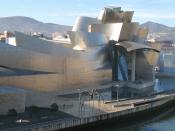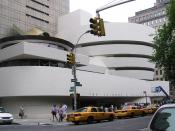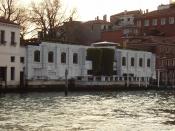Name
Guggenheim Museum Bilbao
Architect
Frank O.Gehry
Date
Groundbreaking: 22nd October 1993
Public Opening
Style Of Architecture
The Guggenheim Museum is a post-modernist piece of avant-garde architecture. It is difficult to categorise because of its unusual and unique shape. Some people would even classify it as a sculpture.
Height
The highest point on the Guggenheim Museum is the glass atrium that is 57m high. The roof of the building stands 34.5m above ground. Level 4 is 29m high whilst level 3 is 22 metres high, level 2 is 15m and level 1 is 7m above ground level.
Materials
The three main materials used in the construction of the Guggenheim Museum were titanium, Spanish limestone and glass. The titanium forms a cladding around the steel frame of the towers on the building. Limestone also clads parts of the building and was used for the stairs and paths around the building. The glass was used to make the 57m high atrium in the centre of the building.
Chapter 3 - Function
The Guggenheim Musuem displays artwork from The Solomon R. Guggenheim Foundation and is one of a handful of buildings that truly interacts with art. It contains galleries of classical proportion and some of more unconventional shapes. The museum contains 19 galleries over 4 levels, one of the the galleries stretches for 130m and is over 25m in width however the incredible thing about it is the fact that it is entirely free of columns, allowing it to display unusually large works of art and sculpture.
Visitors are able to reach different levels of the museum by circling the glass atrium. The atrium, along with additional skylights, provides natural sunlight to the building, including channelled beams which reach over two floors.
The titanium cladding and ships prows on the museum reflect Bilbao's...



Research assignment
Thank you for an interesting essay on the Guggenheim Museum in Bilbao. What you have written gives readers a good description of the museum including its physical layout and architectural design. Your report was well documented and researched, with a helpful bibliography which will be useful to those who wish to do further research in this area. Nice effort!
11 out of 11 people found this comment useful.